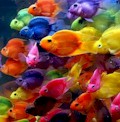Rearing young fish can be a compelling and rewarding hobby. The feeding of fry and their space requirements and culling are discussed below.
Two quite recent fish foods have revolutionized the rearing of fry. These are mikro worms and brine shrimp. Before they were available or had been popularized, raising a tank of two or three hundred young fishes was quite a task. Not all fry can be started on mikro worms or brine shrimp, and some have to be supplied with smaller food for a few days, but a surprising number can eat them from the start, especially the young of the mikro worm, though the parents may be too big.
Thus, newly hatched giant danios (Danio malabaricus), zebra danios {firachydani rerio), glowlight tetras (Hyphessobry con gracilis), head and tail light fish (Hemigrammus ocellifer) and most of the barbs, to cite only a few examples, can take brine shrimp as soon as they are free-swimming.
It is not the size of the young that counts as much as their mouth capacity or even their willingness to accept a particular food. With any given species, it is easy to see whether they are eating brine shrimp because their bellies show a red color even when only one or two have been eaten.
It may be observed that not all the fry are taking them, perhaps only the largest, and it must then be decided whether to arrange for supplementary feeding of the unlucky ones, or to let them starve and raise only the biggest starters. It may be added that either of these newer live foods appears to be a complete and satisfactory food on its own. There is no need to worry about varying the fishes' diet in the early stages if these foods are given.
Space Requirements and CullingYoung fry can stand much crowding. Even when 1/2 inch in length, most species can be packed some 30 or 40 to the gallon. An outstanding exception is the goldfish, in which fry need good space after the first few weeks for adequate growth and must be sorted out fairly early.
The fry of nearly all tropicals can be kept in the small 3- to 5-gallon breeding tank advocated for the first 6 weeks unless there is a spawning, say, of over 250 per tank. In such a case they will do better if given more room after the first 4 weeks. Goldfish fry will stand equal crowding at first, but after 2 to 3 weeks they should be much more liberally provided with space, so that by the time they are 6 to 8 weeks old there should be only about 5 to 10 per gallon, and progressively fewer as they grow up.
In the goldfish, this process will be accompanied in the usual course of events by quite severe culling, so that the capacity of the aquarium is not so badly strained as it might seem at first sight. Culling can start as soon as you can see body and finnage shapes and sizes. Culling for color is impossible until much later.
With all types of goldfish, good shape, finnage, and color are attained by only a very small number - less than 1% is usual. With the fancy types, vast numbers of "throwbacks" occur, some of which are worth keeping as good examples of different classes, but many are useless. The genetics of gold- fish are complex, no doubt made so in part by the reluctance of breeders to inbreed consistently and so help to clean stocks up.
Thus, with the goldfish, culling can be severe. It all depends on your standards and on how many relatively inferior fish you wish to keep for disposal or pond stocking. Few will be worth keeping for further breeding. With tropicals, which throw far fewer abnormal or undesirable forms, it is usually the aim to keep most of the spawning, rejecting only a few runts or badly shaped individuals during the first weeks, and later selecting those which grow best and have the nicest general appearance for breeding.
These few pointers can get you started on this fascinating hobby. Have fun!

